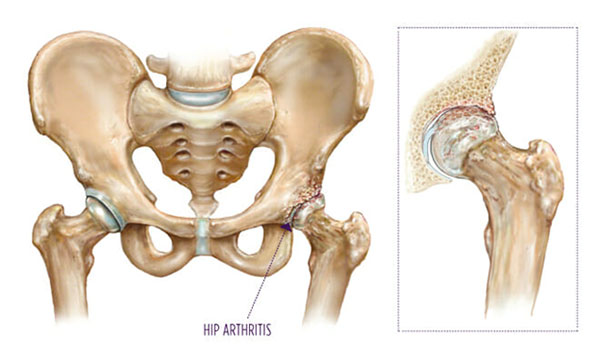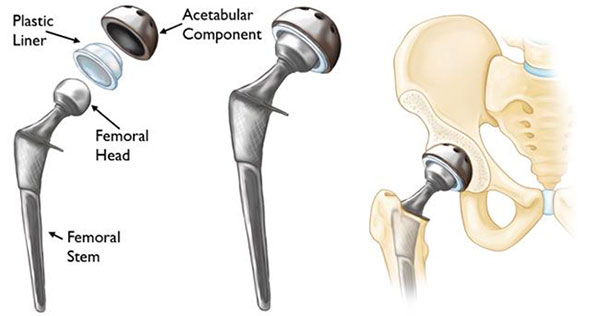Anterior Total Hip Arthroplasty
Total hip replacement is a surgical procedure in which the damaged cartilage and bone is removed from the hip joint and replaced with artificial components. The hip joint is one of the body's largest weight-bearing joints, located between the thigh bone (femur) and the pelvis (acetabulum). It is a ball and socket joint in which the head of the femur is the ball and the pelvic acetabulum forms the socket. The joint surface is covered by a smooth articular cartilage which acts as a cushion and enables smooth movements of the joint.

A number of diseases and conditions can cause damage to the articular cartilage. Total hip replacement surgery is an option to relieve severe arthritis pain that limits your daily activities.
Disease Overview
Arthritis is inflammation of the joints resulting in pain, swelling, stiffness and limited movement. Hip arthritis is a common cause of chronic hip pain and disability. The three most common types of arthritis that affect the hip are:
- Osteoarthritis:It is characterized by progressive wearing away of the cartilage of the joint. As the protective cartilage wears down, the bone ends rub against each other and cause pain in the hip. Rheumatoid arthritis: This is an autoimmune disease in which the tissue lining the joint (synovium) becomes inflamed, resulting in the production of excessive joint fluid (synovial fluid). This leads to loss of cartilage causing pain and stiffness.
- Traumatic arthritis:This is a type of arthritis resulting from a hip injury or fracture. Such injuries can damage the cartilage and cause hip pain and stiffness over a period of time.
Symptoms
The most common symptom of hip arthritis is joint pain and stiffness resulting in limited range of motion. Vigorous activity can increase the pain and stiffness which may cause limping while walking.
Diagnosis
Diagnosis is made by evaluating medical history, physical examination and X-rays.

Surgical Procedure
Surgery may be recommended, if conservative treatment options such as anti-inflammatory medications and physical therapy do not relieve the symptoms.
Dr. Gupta is fellowship trained in outpatient total hip replacement. Over the past five years he has developed a minimally invasive method of performing direct anterior hip replacement that minimizes soft tissue trauma. As a result Dr. Gupta’s patients enjoy a reduced recovery time and less pain around the time of surgery. This allows most patients the ability to go home the same day of surgery.
Dr. Gupta performs direct anterior hip replacement without dislocating the hip, without cutting muscles or tendons, and repairs the joint capsule at the end of the case. The procedure starts by making a 3-4 inch incision over that side of the hip. The joint capsule is opened and persevered. Without dislocating the hip the femoral head is removed. Reamers are then used to prepare the acetabulum and a specialized titanium implant is placed. This implant allows for bone to grow on to the metal. A highly cross-linked polyethylene liner is then placed inside the metal implant. This entire process is performed using fluoroscopy or robotic assistance to ensure the implant is precisely placed.
Using a specialized table designed for direct anterior hip replacement, the femur is then rotated and prepared for a femoral implant. Dr. Gupta takes intra-operative x-rays or robotic navigation of the hip to ensure the patient’s leg length is correct and the implant is in good position. The real hip replacement parts are then installed and checked for range of motion. This has allowed Dr. Gupta to have an infection rate of less than one in 200 primary joint replacements!
One of the keys to outpatient joint replacement is pain control. Dr. Gupta performs an intra-operative pain block on all hip and knee replacements. This block eliminates pain for the first 24-48 hours and typically does not cause any muscle weakness. The entire surgery takes just over an hour. After surgery patients walk without restrictions and are ready to sleep in their own bed!
Risks
As with any major surgical procedure, there are certain potential risks and complications involved with total hip replacement surgery. The possible complications after total hip replacement include:
- Infection
- Dislocation
- Fracture of the femur or pelvis
- Injury to nerves or blood vessels
- Formation of blood clots in the leg veins
- Leg length inequality
- Hip prosthesis may wear out
- Failure to relieve pain
- Scar formation
- Pressure sores
Total hip replacement is one of the most successful orthopedic procedures performed for patients with hip arthritis. This procedure can relieve pain, restore function, improve your movements at work and play, and provide you with a better quality of life.
Dr. Gupta to give a lecture series at Georgetown yoga "Healthy Movements Workshop" focused specifically on hip, knee, and shoulder injury prevention and those patients with existing injuries in April and May.
Dr. Gupta is now "board certified" in Orthopedic Surgery.
Dr. Gupta to present Orthopedic Lecture Series with Sentara Northern Virginia Medical Center titled "Don't Let Hip Pain Slow You Down: Understanding Your Options", September 7th, 2016 at Hilton Garden Inn Woodbridge at 6pm.
Dr. Gupta to present third part of his lecture series on "Master Mobility" at Spark Yoga. His next lecture with be on "Mastering Mobility Of Your Knees" on September 18th at The Shops at Pershing, 2201 N Pershing Dr, Arlington, VA 22201










